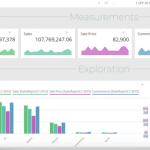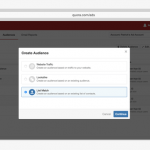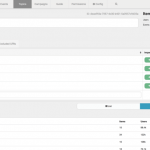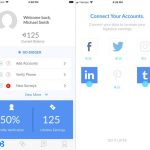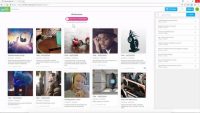Flipboard’s Quest To Save Online Publishing—And Itself
The iPad was a futuristic gadget when it debuted in April 2010, but the apps it presented offered a rather nostalgic revival of traditional media. Photos, graphics, magazines, and books optimized for its high-res screen featured a print-era visual polish that had been sorely missing from ad-crammed web pages and monochrome ebook readers.
One of the early hits was Flipboard, a graphical embodiment of social media that launched in July 2010. It turned Twitter and Facebook feeds into an online magazine by displaying the photos, articles, or other pages that people linked to. Previews of articles were laid out like items on a newspaper page; and flicking up on the screen triggered a visual effect that looked like flipping pages. Flipboard was among the top 10 iPad apps in its early days, according to rankings by AppAnnie. “It seemed to be a perfectly timed creature of the iPad age, of the tablet age,” says digital advertising consultant Ken Doctor, author of the book Newsonomics: Twelve New Trends That Will Shape the News You Get.
But what about the current age—with tablet sales slumping, phablet phones gone mainstream, and ever-more competition, be it Facebook, Apple’s News app, or even Snapchat? “It’s kinda like the beautiful little toe of the internet,” says Doctor of Flipboard. “You don’t really need it, but it is a really good-looking little toe, and it works well.” Flipboard has just launched a massive revamp, Version 4, in the hopes that people will feel they need it. About 97% of Flipboard downloads are now on smartphones, and that’s where the revamp starts, with upgrades for iOS and Android phones.

On the surface, the new Flipboard doesn’t look much different, and in some ways may be less intuitive. Under the hood, however, it’s enriched with better artificial intelligence to both refine the articles you see and banish sites that fling atrocious advertising or fake news at readers. The killer feature, though, remains its social component. Users have created and shared about 30 million collections of articles about their favorite topics and those can be bundled together to create magazines, and published for everyone else to read. Flipboard also pulls in content from over a dozen social networks. The latest update—being released today—is an attempt to make the app more approachable for newcomers. And while Flipboard still has a learning curve that may exceed many people’s patience, those who hang in will discover a different and enriched way to browse the news.
I’ve been meeting with CEO Mike McCue and his team since the summer as they worked to fold Flipboard’s increasingly complex inner workings into a straightforward package. It’s been a long process: The launch was slated for some time in November, then pushed to December 8, then January 26. Now, it’s ready.
A Different World
Flipboard calls itself a “social news magazine;” others call it a newsreader. That’s just one of the gaps between internal and external perceptions of Flipboard that have posed a challenge for the company.
The company has already survived plenty of tech, media, and business changes. Twitter began restricting access to the network—for all third-party apps—in 2012; and Twitter user growth has stagnated (and it’s laid off staff). Facebook is the biggest home of news—some of it fake; and Apple News now has choice real estate on iPhones.
In 2015, Flipboard reportedly pulled out of acquisition talks with Twitter (McCue won’t comment on it). It lost several senior staffers, including cofounder Evan Doll (who ultimately returned to Apple to run its health software division); and it fell short of ad sale projections. The company has yet to make a profit. “We’ve always had high expectations for what we can do around revenue,” admits McCue.

But Flipboard has also grown to over 100 million monthly active users, he says, and it has cash left from $210 million of investment (providing an $800 million valuation). Flipboard’s redesign, version 4.0, promises to harness the latest technology to improve the reading experience, combining artificial intelligence with user feedback to weed out poor journalism and crappy advertising—two menaces of the post-truth web. New AI capabilities also promise very fine-grained, customized content offerings.
At the same time, McCue is rejecting robo-driven “programmatic” advertising that packs web pages and app screens with adverts about belly fat or links to fake news. He’s using humans to sell premium-priced slots for magazine-style ad campaigns from upscale brands. The model is not Yahoo News but rather a newsstand copy of Vogue. “We’ve had a very ambitious goal around reforming advertising,” says McCue. “We’ll either live or die based on that.”
The Anti-Web
McCue wasn’t out to build just an app, he says; the tech veteran wanted to rebuild the very web he’d helped construct. In 1989 McCue founded Paper Software, whose virtual-reality browser tech was acquired by Netscape, and he subsequently founded Tellme Networks, a mobile “voice-browser,” as he calls it. Before the age of smartphone apps, people called a toll-free number to ask questions of Tellme’s speech-recognition system. Microsoft bought Tellme in 2007 for a reported $800 million, eventually folding the technology into its voice interfaces for Ford cars, Xbox, and the Cortana virtual assistant.
Flipboard emerged from a series of weekend brainstorming sessions at McCue’s house in 2009 with about 15 friends and former colleagues from Paper, Netscape, and Tellme. Among them were iPhone software engineer Evan Doll and John Giannandrea, who’s now Google’s SVP of engineering. “What if the web was accidentally deleted and we needed to build a new web, knowing everything we know today, that the world is moving to mobile, that it’s moving to social, that people now are nodes on this web, just like websites?” McCue says he asked his friends. “What would we do differently?” Doll joined McCue as a cofounder of what would become Flipboard (though only McCue put up money). Other people from the meeting joined as advisors.
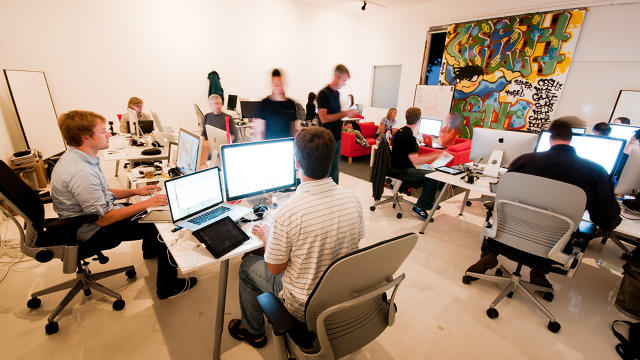
For content, they started with Twitter. For a design metaphor, they reached to that old-media mainstay, magazines. “The content [on the web] wasn’t structured,” says Marci Pedrazzi McCue, Mike’s wife and Flipboard’s head of marketing and PR. (They met when she joined Tellme in 2000.) “It was like, how do I go to one place to see all of the things I want, instead of these separate silos? And so the concept of the magazine as the organizing principle for all the content that was out there, was very early on in the thinking,” she says.
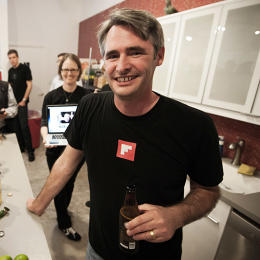
Dressed in faded jeans, white converse sneakers, and a Patagonia jacket, silver-haired Mike McCue sports the de rigueur casual style of the Valley. But he is also a bit folksy. A gap between his front teeth makes for a disarming smile, and a twang in his voice is reminiscent of Fred Rogers. Flipping through a magazine created by a user called Nikon Girl, the pitch of his voice rises. “This is an article about a Leica camera, which to me is like, OK, this is like awesome to me,” he says, jumping back in his chair. He may be exaggerating to convince me how cool the product is, but it doesn’t feel fake.
Sitting in Flipboard’s conference room, along with Marci (who wears a colorful scarf and fashion-statement orange horned rim-style glasses), we reminisce about when news came from the newsstand. I wonder, are magazines for old folks like us? “A magazine is a timeless concept—a collection of ideas packaged together, for a passionate audience,” says Mike. He posits that the firehose of information from services like Twitter is what’s getting old. Flipboard staffers, even the one third (out of about 150) who are under 30 years old, get the revamped magazine concept. “They’re tired of the relentless, nonstructured newsfeed,” he says.
The Curated Internet
One challenge to Flipboard’s magazine metaphor is that it’s gotten muddled over the years. When it was built mainly on social networks, Flipboard was essentially a feed, albeit a very pretty one. “It became clear that you couldn’t depend on the Twitter API,” says Mike of the application program interface required to tie apps into Twitter. The network was limiting third-party access to data and imposing restrictive design guidelines and certification requirements. Flipboard added other news sources and also hired editors to vet and select what to include.
With Version 2, launched in March 2012, Flipboard became more social by enabling users to make their own content collections, called magazines, on any topic. “This was HUGE because now people were adding new blogs and sources to our network. This is when the ecosystem opened up,” Marci tells me in an email. That’s a key difference between Flipboard and standard news readers—the user community.
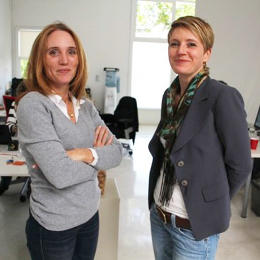
“People who get into curation really get into it. They’ll have 20, 30, 40 magazines,” says Mike. “You’d be amazed the number of socks magazines on Flipboard.” I counted at least 30. Some user collections are private, most are available for anyone to subscribe to, and many are collaborative. Mike contributes to magazines for Leica cameras and wooden boats—two of his passions.
California lieutenant governor Gavin Newsom regularly curates eight magazines on topics like gun control, environment, and immigration. Football player/astronaut Leland Melvin flips articles, photos, and videos to five magazines. Al Gore sporadically posts articles, generally by or about him; and Bob Villa promotes his own material.
In October 2014, Version 3.0 finally brought in artificial intelligence, courtesy of Flipboard’s purchase of newsreader Zite (from CNN) earlier that year. Flipboard closed the service, spurring a lot of negative Flipboard reviews among Zite fans, but it gained a team of AI developers. Editors still curate the main topic areas, but now the vast majority is generated by algorithms. Altogether, Flipboard has about 10,000 topic areas—an overwhelming list for new users to scroll through, let alone chose from and read about.
There must be something to this setup, since others have copied it. Apple News also has topic areas, although its emphasis seems to be on following specific sources, like the New York Times, The Economist, Fox News, or Fast Company. An app called News360 is a closer copy, with its own seemingly endless list of topics.
Flipboard also remains the prettier app, thanks in part to partnerships that integrate about 200 big English-language publishers (and additional ones for other languages) into its interface with large photos and the flip animation. They include Bleacher Report, Bloomberg, BuzzFeed, CNET, CNN, Fast Company, Fox News, Huffington Post, The New York Times, People Magazine, Road & Track, Vogue, The Wall Street Journal, and Wired. The relationship also allows Flipboard to share advertising revenue. Flipboard has simpler arrangements with tens of thousands of smaller sources, which appear just as web pages within the app and don’t bring in ad dollars.
In addition to aggregating, Flipboard invests a lot of resources in hand-selected content. It has hired journalists like Josh Quittner of Time magazine and former CNN producer Gaby Schwartz to select specific articles for a general news “Daily Edition,” as well as topic categories: business, politics, sports, technology, and celebrity news. Steve Fine, former director of photography at Sports Illustrated, plays a similar role at Flipboard.
A Critical Upgrade
The new app, which I tried in beta, opens with the question: “What’s your passion?” You can search for almost any topic from its list of about 10,000 and get either the exact thing or something pretty close. I experimented with a search for “German Philosophy,” which isn’t one of Flipboard’s topic areas. But it recommended Western Philosophy and offered subcategories to home in on, such as Nietzsche, Heidegger, and Wittgenstein.
I could also make a wide, eclectic collection of topics. Under History, I picked Ancient Egypt, Alexander Hamilton, and Roman Empire, but skipped Canadian History and American Civil War. This fine-tuning was in earlier versions of the app, but was harder to find.
So what’s a Flipboard magazine—the packages put together by editors, the user-curated collections, or the overall feed based on the topic areas and the user-curated collections people follow? Flipboard simply calls all those things magazines now. “What 4.0 tries to do is…make it a lot more accessible to our users so they don’t have to know, wait, am I following a magazine? Or a topic? Or a person?” says Mike.
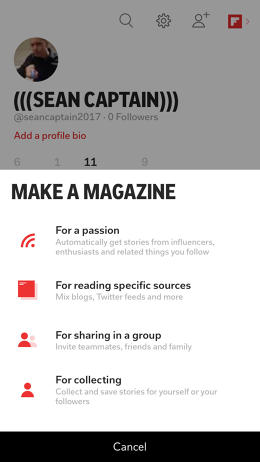
However the new app also adds questions. When I started to make a magazine, it first asked me to select one of four choices: “For a passion” (based on interests), “For reading specific sources,” “For sharing in a group,” or “For collecting” (personal collections that can be public or private). I scratched my head for a while. There are fine-print descriptions of each option, but it’s a lot to absorb on your first button click.
Under my profile screen of the app, there are similar-looking collections of topics under two sections: Magazines and Following. I had to ask Mike to explain the difference. Magazines are ones that I’ve created in some form—be they ones generated by keywords and algorithms (now called Smart Magazines, like my philosophy and history ones) or collections I add individual articles to, like one on the topics that I write about. It took me a few minutes to be sure I understood the difference. “Following” meanwhile, refers to magazines that other people have created, like a humorous one about androids called Sexy Robots. Those are a lot of fine distinctions for the uninitiated to keep track of—or even to care about. Overall, though, I wouldn’t say that the new app’s interface is more intuitive than the previous version.
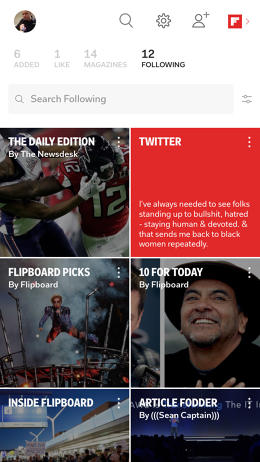
The clunkiness may not matter so much if Flipboard can deliver on its biggest promise: more fine-tuned, personalized content. It aims to do this with an AI engine called Flavour that Mike describes as a Pandora station for news. Flavour uses natural language processing and machine learning to assess the content of any article, or even a tweet, in fine-grained detail, he promises.
One goal of Flavour is that users won’t have to worry about where content is coming from. It creates Smart Magazines using feeds from all of Flipboard’s possible sources, including articles selected by the editors, feeds from premium content providers and other sites, user magazines, and feeds from hand-selected Twitter “influencers”—currently over 3,000 as diverse as Ryan Seacrest, Elon Musk, and Kellyanne Conway.
The promise is that Flavour will weed information by the user’s interest areas. Someone into startups, for instance, might get celeb investor Gary Vaynerchuk’s tweets on that topic, but not posts about the great dinner he had. Mike may not get every article from Nikon Girl’s magazine, but he should get the ones about Leica cameras. A user can up- or down-vote any article to refine the filters—upgrading a feature in Version 3.0 that never worked well.
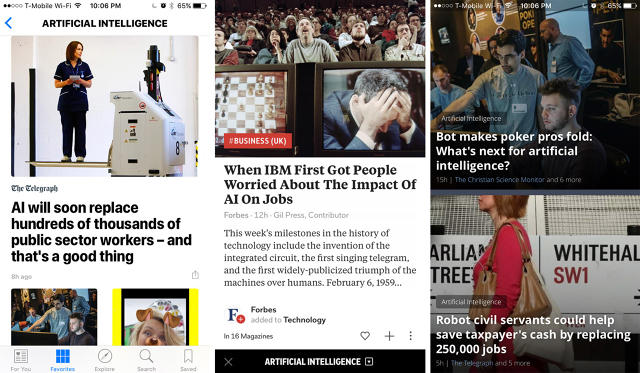
To assess how it works, I followed a few topics on the new Flipboard, Apple News, and News360. Articles in the “AI” category overlapped more than half the time, and the three apps all hit the same major stories. Under the less-mainstream Archeology topic, Flipboard and News360 had a lot more in common with each other than with Apple, whose articles were also older.
I especially enjoyed the stories that both Flipboard and News360 brought up, but Flipboard has a lot more customization options. Beyond Twitter and Facebook, Flipboard users can link to an additional 11 social networks to pull in content, such as LinkedIn, Sina Weibo, SoundCloud, YouTube, and Pinterest. A pop-up menu in articles, which Marci had to show me, allowed me to not only like an article, but to “less like” it, similar to a thumbs down that tunes a Pandora radio station.
Personalization enabled by AI will be the big new development in online news, says Ken Doctor, putting Flipboard in competition with the original news sources it draws on. “Flipboard was an early innovator out there…in personalization,” he says. “If others are able to increasingly personalize the experience on their own brands—on news-creating brands and features-creating brands—I wonder if that can make Flipboard less differentiated, less attractive.”
Flipping A Profit?
The biggest publishers are key to Flipboard getting to profitability, which the McCues say they aim for “in a couple years.” Mike won’t say how much Flipboard is currently bringing in, but he hints at a range. “To get a company of 160-some people [to profitability], you need about somewhere in the range of $50-$80 million in revenue annually,” he says. “We are well over more than halfway there.”
Flipboard doesn’t make money off ads from most sites, but it does with the 200-some premium sources through ad revenue sharing deals. If a publisher sells and runs the ad, Flipboard gets a cut. If Flipboard’s own sales team sells ads across a topic area, the premium sites that contribute to that area get their cut.
For all the other sources, the focus is to minimize crappy ads. In the new app, users will be able to report sites with annoying advertising, as well as fake news. Flipboard has also developed an algorithm to flag bad sites by scanning features like domain name practices commonly used by bots and spam sites, or user behavior like leaving the site almost immediately after landing on it. Such crummy sites won’t get pulled into Flipboard magazines anymore.
Meanwhile, sources big and small that Flipboard knows to be good in terms of content and advertising, from Vanity Fair to Gardenista, will get extra weighting that makes them more likely to come up. The challenge is that, no matter how many sources Flipboard vets, users can always add more.
For the sites that are part of the flip interface, Mike doesn’t allow pop-ups or banners—or any ads on a page of content. Instead, ads appear between pages. Users come across what are essentially full-page ads while flipping through an article—as they would in a copy of Vogue. (Flipboard in fact hired a former Vogue staffer, as well as ad and marketing people from publishers including the New York Times, the Financial Times, News Corp., NBC Universal, and Martha Stewart Living Omnimedia.)
Flipboard is focusing on lavish advertising packages. One by United Airlines, for instance, starts as a one-pager, but readers can scroll to the right, to experience something like a magazine spread, and then continue to even more pages. It also features video, an advertising genre that Flipboard is aggressively trying to grow.
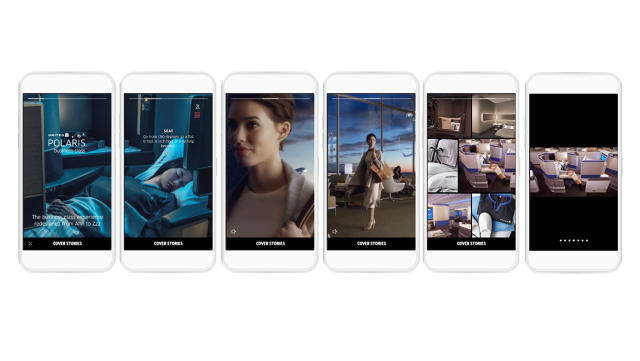
The experience reminds me of iAds, Apple’s ambitious, failed program to get advertisers to produce media-rich advertising within iPhone and iPad apps. “If you clicked on it, then it took you to this awesome experience—which took forever [for advertisers] to build,” says Mike. He says that the United ad was made quickly from photos the company already had, and video taken from a TV commercial.
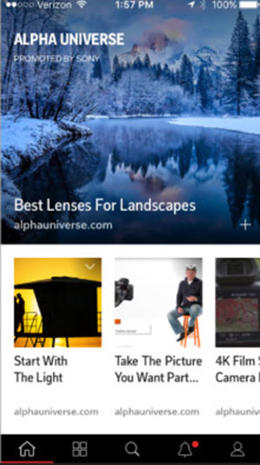
The big reason Flipboard is going after magazine-style ads: That’s where the money is. Global media and marketing for 2016 was estimated by Advertising Age at $965.1 billion, of which only around one-third is online. Mike is betting that high-end advertising, the kind you see in Vogue, will start making the move to digital, and that Flipboard will become a preferred platform. “And the neat thing about that is, you don’t need a billion users to make a billion dollars,” he says. “You need 100-ish million users or 50 million users that are really engaged.”
Flipboard faces enormous competition for online advertising—led by the marketing and targeting power of Google and Facebook. Flipboard is just one among ever more places to advertise, says Ken Doctor. “With all the distribution possibilities the publishers now have, with Facebook and Google and Apple, Snapchat and all, what I’ve heard [from the publishing partners] is, not a high priority, because we don’t see that much impact from [Flipboard],” he says.
Mike says that advertisers “love” Flipboard’s ad options, but the proof will come in revenue. Flipboard is currently selling just 20% of its ad inventory, he tells me, though he claims Flipboard doesn’t need to get near 100%. “It’s more like, I’d love to go from selling 20% of our inventory to 30%. That’s a huge amount of additional revenue,” he says, enough to make the company profitable. Even if Flipboard can make its revenue goals, it won’t happen soon. “It’s gonna take time, it’s gonna take years,” says Mike. “We’re signed up for that.”
Fast Company , Read Full Story
(54)



